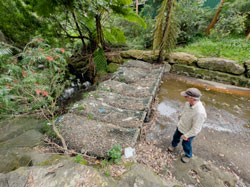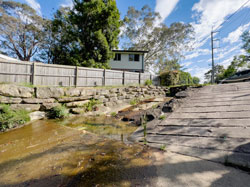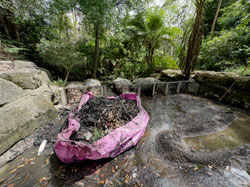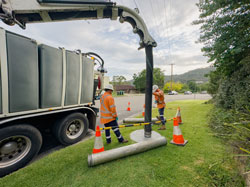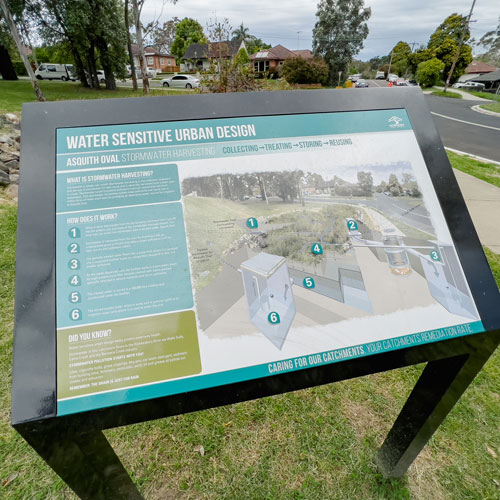
Did you know that the stormwater network is separate from the sewer system? What you do outside with your car wash detergent, paint brushes, fertiliser, grass clippings, dog poo and other waste has a big impact on our local waterways.
The cumulative effects of everyone's actions have significant impacts on our creeks, streams, treasured swimming spots and even our oceans.
We can all play a part in minimising stormwater pollution. Read on below to discover how you can make some small changes at home that will see positive changes downstream.
What is stormwater?
Stormwater, or rainwater runoff, is rainwater that runs off roofs, driveways and roads. It is carried away by a series of pits and pipes known as the stormwater drainage network to our natural water bodies, such as creeks, rivers, estuaries and the sea.
Stormwater runoff from Hornsby Shire drains to two major catchment areas. Generally, runoff north of Pennant Hills Road drains to Berowra or Cowan Creek before flowing into the Hawkesbury River. Runoff south of Pennant Hills Road will flow into the Lane Cove River and Sydney Harbour.
As water runs over roofs, paths and gutters it picks up and carries with it any pollutants it comes into contact with. The faster water moves on hard surfaces, the more particles it can pick up along the way.
Local stormwater is usually untreated, but we do our best to improve the health of our creeks. We've already installed over 400 Stormwater Quality Improvement Devices (SQIDs) for stormwater to pass through. This is helping, but we still need to do our best to ensure that stormwater entering drains is as free of pollutants as possible.
What exactly is a SQID? (It's got nothing to do with salt and pepper!)
A Stormwater Quality Improvement Device (SQID) is a trap that filters out stormwater pollutants before they enter local waterways and the ocean. We use eight different types of SQIDs around the Shire – basket trap, trash rack, pit insert, biofilter, net tech, channel net, underground CDS & sediment basin – to trap different pollutants. On average, our 400 SQIDs collectively capture over 700 tonnes of gross pollutants each year.
Why is stormwater pollution an issue?
Stormwater pollution is usually referred to as diffuse pollution because it does not come from one readily identifiable source, rather from a range of sources over a large area that cumulatively have significant environmental impacts.
Polluted stormwater can cause significant ecological changes to waterways, includingreduced oxygen and suffocation for aquatic wildlife and reduced water clarity which limits sunlight penetration and photosynthesis of aquatic plants.
Stormwater pollutants can come from commercial sites and often include illegal spills and discharges and sediment from poor building site management. But residential sources like garden chemicals from fertilisers and pesticides, nutrients from lawn clippings and garden waste, as well as weeds, soil and mulch are also very common.
Nutrients and bacteria from dog poo, leaking sewer systems, cars (including leaking engine oil and brake fluid, tyres and brake linings, and car washing detergent) and litter (includingplastic, polystyrene, glass, paper, cigarette butts, and sediments) are also regularly present pollutants in our local waterways.
What can you do to help?
- Wash your car on the lawn or use a local car wash that recycles water.
- When using water-based paint, clean brushes over grass and soil.
- When using oil-based paint, keep paint, turps and solvents clear of gutters and drains. Turps can be re-used once the paint has settled.
- Prevent building materials and garden waste from entering stormwater drains.
- Dispose of litter properly and opt for reusable products.
- Sweep your street gutter and driveway, then mulch or compost grass clippings and leaf litter.
- Reduce fertiliser and chemical use in your garden.
- Pick up after your dog.
Remember, the drain is just for rain. To learn more, see: https://www.hornsby.nsw.gov.au/waterways
Click on images to englarge.

